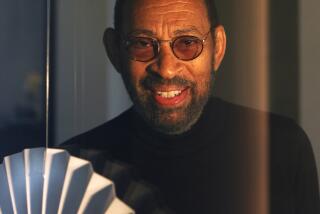James ‘Buster’ Brown, 88; Tap Dancer
- Share via
Veteran tap dancer, choreographer and teacher James “Buster” Brown has died. He was 88.
Brown died Tuesday at Columbia Presbyterian Hospital in New York City. The cause of death was not announced.
“Buster was so smooth as a dancer, he never showed any effort,” tap historian Leonard Reed said Thursday. “Sometimes he looked like he wasn’t dancing at all, just floating in the air. He danced like silk.”
Brown, described by the Calgary (Canada) Herald in 1996 as “the small, wiry dancer with the thin mustache and two-tone tap shoes,” was born in Baltimore on May 17, 1913, and learned tap on the street.
“We taught each other,” he said in a 1992 interview with the London Sunday Telegraph. “We’d see a show at our hometown theater, the Royal, we’d see a guy on stage, do a step and we’d steal it.”
At age 16, he and two friends from Douglas High School became the Three Aces and later the Speed Kings, performing what he described as a mix of acrobatics, tap dance and jive.
As a solo tap artist, Brown toured with Cab Calloway, Count Basie, Dizzy Gillespie and others, but he always spoke of working with Duke Ellington as the highlight of his career.
“It was like going to heaven,” he said in a 1999 interview in the New York Amsterdam News. “He was the greatest musician to have ever lived. He played very elegantly and I looked up to him.”
Along the way, Brown became a member of the Original Hoofers performing group and the Copasetics, founded in memory of tap legend Bill “Bojangles” Robinson.
And after a number of lean years for tap, when he made ends meet as a clerk in a hotel and by cleaning buildings, Brown and other aging tappers lent their dancing and teaching talents to a tap rebirth in the late 1970s.
During this new flowering of tap, Brown danced on Broadway in “Bubbling Brown Sugar” and “Black and Blue,” on film in “Tap” and “The Cotton Club,” and on television in a PBS “Gershwin Gala” and a “Dance in America” tap special. He also toured as a guest with concert tap companies through the 1990s.
Current tap phenomenon Savion Glover paid tribute to Brown’s influence in a major solo in his 1995 Broadway musical “Bring in ‘Da Noise, Bring in ‘Da Funk,” and Brown appeared locally with Glover in “Foot Notes--the Concert” at the Wilshire Theatre in 2000.
Reviewing that performance, The Times wrote that “dancing to ‘April in Paris,’ octogenarian James ‘Buster’ Brown exemplifies the sharpness and physical/spatial economy of classic Copasetics club style: nothing wasted, except maybe some of the jokes between numbers.”
Just this year, Oklahoma City University awarded him an honorary doctorate and, according to Linda Sohl-Donnell, artistic director of the Los Angeles-based Rhapsody in Taps company, he continued to perform in, and host, a weekly jam session for tap dancers at the Swing 46 club in New York until a few months ago.
“He was an inspiration and a very dear friend and supporter to tap dancers of all ages,” Sohl-Donnell told The Times. “He was also a gracious and very positive human being, besides being a fabulous tap dancer.”
To the end, Brown relished being an elder statesman of tap.
“Dancing has taken me all over the place,” he told National Public Radio in 1999, “and I appreciate it and I respect tap dancing.... I tell most of the kids that are coming up, I say, ‘If you love something, you must respect it. Don’t do anything to put any smudges in it, you know? Wherever you dance, leave something for the next dancer that comes in, something clean, not anything derogatory.’ Remember that? Yeah.”
More to Read
The biggest entertainment stories
Get our big stories about Hollywood, film, television, music, arts, culture and more right in your inbox as soon as they publish.
You may occasionally receive promotional content from the Los Angeles Times.










